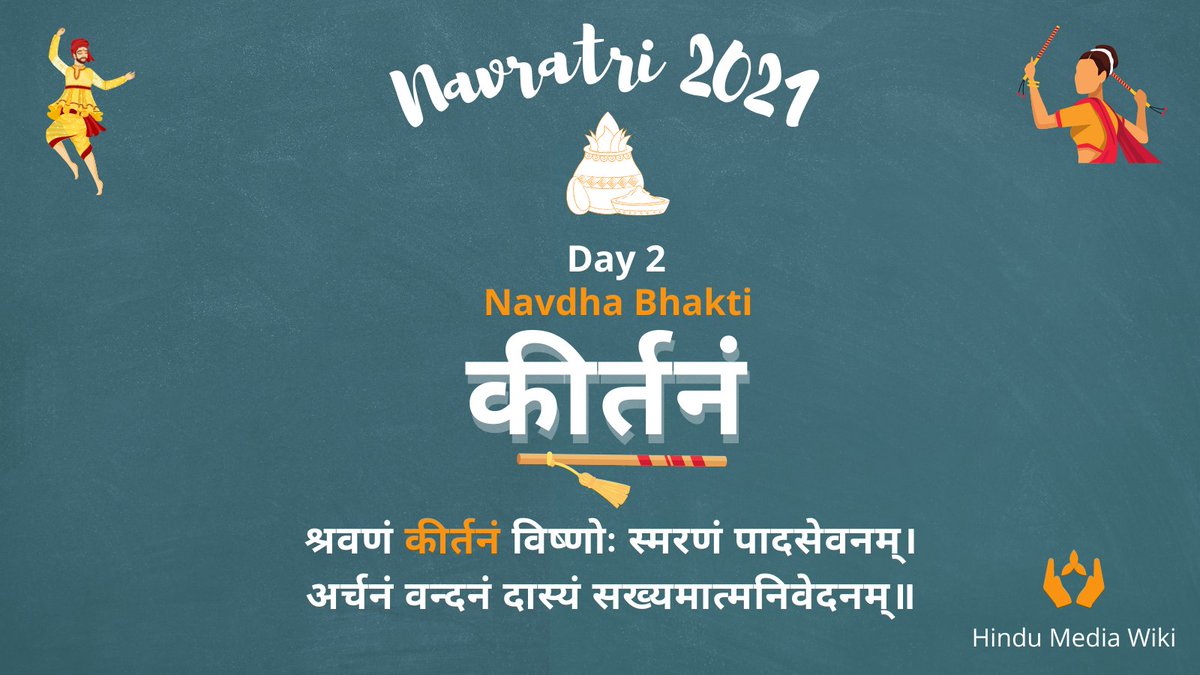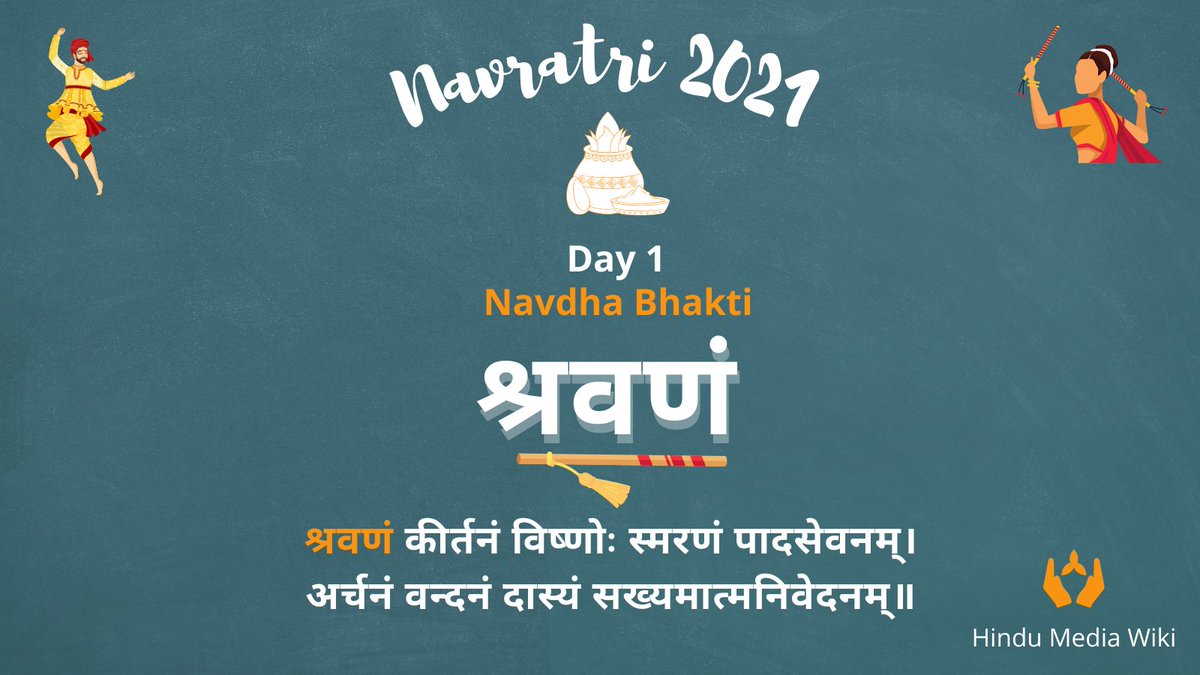
Hindu scriptures provide the 9 steps of Bhakti known as Navdha Bhakti.
Today is Day 2 of #navratri 2021 and we are going to discuss what is Kirtanam!
कीर्तन - Kirtan (Telling/Discussing) with joy and enthusiasm of God's qualities, character. 1/10
Today is Day 2 of #navratri 2021 and we are going to discuss what is Kirtanam!
कीर्तन - Kirtan (Telling/Discussing) with joy and enthusiasm of God's qualities, character. 1/10
https://twitter.com/HinduMediaWiki/status/1445972359643422724

Kīrtana (कीर्तन, “glorifying”) refers to one of the three rites mentioned in the Śivapurāṇa 1.3.
"Śravaṇa is the first rite. The intelligent scholar must listen to the oral explanation of the preceptor and then practice the other rites.—Kīrtana and Manana(deliberation)”.
"Śravaṇa is the first rite. The intelligent scholar must listen to the oral explanation of the preceptor and then practice the other rites.—Kīrtana and Manana(deliberation)”.
According to Śivapurāṇa 1.4, “Śravaṇa (listening) is effected when one associates with good men. Then the Kīrtana of Paśupati becomes steady.
In the end is the Manana which is the most excellent. All these take place as a result of benevolent surveillance of Lord Śiva”.
In the end is the Manana which is the most excellent. All these take place as a result of benevolent surveillance of Lord Śiva”.
Śivapurāṇa 2.2.26 Explains Kīrtana (‘eulogising’) in details:
"after conceiving in the mind the details of my manifestations and activities, loudly and cheerfully, proclaiming the same in order to eulogise me is what is called eulogising". -
"after conceiving in the mind the details of my manifestations and activities, loudly and cheerfully, proclaiming the same in order to eulogise me is what is called eulogising". -
Also, many of your know that Different Vaishnava Purana Talks about Bhakti but to many should be aware that Shiv Purana Also talks Nevadha Bhatki (9 forms of Bhakti) at length.
It also define the word "Kirtana" and explains its important.
It also define the word "Kirtana" and explains its important.
Kīrtana (“eulogising”) represents one of the nine-fold (navadhā) devotion (bhakti), as explained in the Śivapurāṇa 2.2.23, as Śiva said to Satī:
"O Goddess Satī, listen, I shall explain the great principle whereby the remorseful creature becomes a liberated soul (mukta)...
"O Goddess Satī, listen, I shall explain the great principle whereby the remorseful creature becomes a liberated soul (mukta)...
...Devotion (bhakti) to me is considered as the bestower of worldly pleasures and salvation. It is achievable only by my grace. It is nine-fold (navadhā) [viz., kīrtana].
There is no difference between devotion and perfect knowledge...
There is no difference between devotion and perfect knowledge...
A person who is engrossed in devotion enjoys perpetual happiness. Perfect knowledge never descends in a vicious person averse to devotion."
Thus kirtan is not just done with song or music, but its retelling of God's any discourse with joy and faith.
Thus kirtan is not just done with song or music, but its retelling of God's any discourse with joy and faith.
In Bhajana-Rahasya book Kīrtana (कीर्तन) refers to:
(1) congregational singing of Śrī Kṛṣṇa’s holy name,
(2) loud individual chanting of the holy name or
(3) oral descriptions of the glories of Śrī Kṛṣṇa’s names, forms, qualities, associates and pastimes.
(1) congregational singing of Śrī Kṛṣṇa’s holy name,
(2) loud individual chanting of the holy name or
(3) oral descriptions of the glories of Śrī Kṛṣṇa’s names, forms, qualities, associates and pastimes.
As Ramchartimanas rightly put as second step of bhakti:
"दुसरि रति मम कथा प्रसंगा॥"
The second step is to enjoy listening to legends/discourses pertaining to the Lord
This is what kirtan means! You can also ask your Guru that why Kirtan is important, it is self-discovery task
"दुसरि रति मम कथा प्रसंगा॥"
The second step is to enjoy listening to legends/discourses pertaining to the Lord
This is what kirtan means! You can also ask your Guru that why Kirtan is important, it is self-discovery task
Stay tuned to this Introduction to Navdha Bhakti series as a Digital Upasana on #Navratri 2021 :)
• • •
Missing some Tweet in this thread? You can try to
force a refresh







